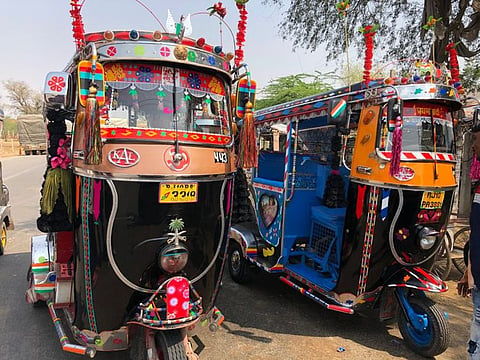A dazzling journey on Rajasthan’s Sardarshahar Tuktuk
It is a cultural experience which takes you into the local aesthetic traditions

Sardarshahar: Sardarshahar is a small town in the Churu district of Rajasthan, not very far from the border with Pakistan.
Once an important commercial hub located on the crossroads of an ancient trade route, this desert town has absorbed myriad cultures brought in by the visitors from different parts of Asia.
As a result, the town now boasts of a very vibrant and colourful aesthetic tradition that not only reflects in its ageing buildings but also in its most popular transportation mode — the tuktuk.
Sardarshahar is part of the distinctive Shekhawati heritage covering several adjoining towns such as Mandawa, Churu, Ramgarh, Fatehpur and Mahansar, known specifically for their ornate mansions, but equally attractive and unique are these diesel-powered auto-rickshaws from the region.
Tuktuk or the tempo, as it is called in Sardarshahar, is not just a mode of transport in this Rajasthani town. It is a cultural experience, a journey into the local aesthetic traditions.
Appealing from outside with their range of tassels, mirrors and shiny sticker art, these vehicles are no less flashy from inside, awash with bright colour seats, tinted lamps and floral patterns.
“People here love vibrant colours and flashy designs. The design and the colours are derived from the rich local heritage that can be seen in the way people dress, especially women, the way they decorate their animals and build their houses,” says Vimal Singh, an auto driver with one of the most decorated tuktuks in town.
Most visible object on the road
Flashy decorations are not just confined to tuktuks, as camel carts and trucks in Rajasthan also get similar treatments, but the Sardarshahar tuktuk is a case apart.
“Tuktuk is the primary mode of transport in town and is the most visible object on the road. So, with the way people in the town think, it becomes a status symbol, a style statement as well as a way to appeal the customers,” said Mohammad Shahrukh, another auto driver.
Unique in its design, structure and look, the Sardarshahar tukuk is a mechanised, three-wheeled tonga, with seating arrangements for six people in rows behind each other.
“Before the tuktuks, tongas or horse buggies were used for transport, the traditional tongas also had similar carriages with two rows of seating with backs to each other and a seat in front for the driver. The design has been carried forward for the tuktuks with similar style elements,” adds Shahrukh.
The Kerala connection
Run on diesel, the chassis and engines of these vehicles are brought from Kerala, but the tuktuks get their distinct shape at local factories in the Rajasthani capital of Jaipur and Sardarshahar.
The basic models of the three-wheelers cost around Rs180,000, but the vehicle owners spend as much as Rs100,000 in decorations and modifications, competing with each other to make their vehicles flashier than those of others.
“This is all about passion. The tempos are customised according to the vision of the owner. Right from the colour combinations and material used to the number of mirrors and tassels to the music system, every inch of the vehicle is made to order,” says Mani Ram, another tuktuk driver.
With all the cost of customisation and its regular maintenance, one might think that the rides on the tuktuk might come at a cost, but surprisingly it is quite affordable.
“There are around 7,000 tuktuks in the town, for a population of around 100,000, so the competition is quite stiff and the rates are standardised at a minimum of Rs10 per head for up to 3km and Rs20 per person for anywhere beyond,” adds Singh.
Singh is so passionate about keeping his vehicle in perfect condition that he spends Rs2,000 on its maintenance every month and makes sure no passenger steps into his vehicle with any goods which could lead to any wear and tear.
Most of the other drivers are no less in their zeal for keeping the vehicle in prime shape, because for them taking care of the vehicle is important as keeping their tradition alive.
So, next time when you are in Sardarshahar, pick the flashiest of the tuktuks and enjoy some local aesthetics on the move!
— Shafaat Shahbandari is a Bengaluru-based independent journalist. He is the founder of Thousand Shades of India, an alternative media platform that celebrates the diversity of India.
Sign up for the Daily Briefing
Get the latest news and updates straight to your inbox






